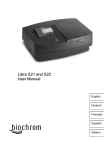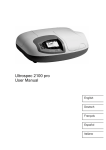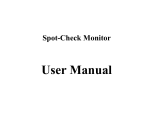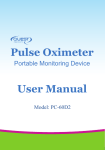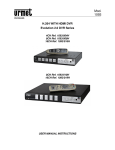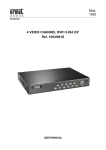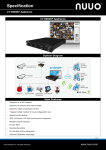Download ENGLISH
Transcript
ENGLISH GENERAL DESCRIPTION FLR100 and FL100 are the optical beam smoke detectors whose working principle is based on the attenuation of the light intensity of an infrared light beam due to smoke. The infrared light beam is transmitted by a transmitter unit (Tx) and received and properly processed by a receiver unit (Rx). More specifically, the receiver unit Rx processes an electrical signal proportional to the intensity of the received light and notifies an alarm or fault condition if the signal falls below an alarm or fault threshold continuously for a predefined amount of time. FLR100 and FL100 can work in either one of the following configurations: • transmitter/receiver unit FLR100 (Tx/Rx) + passive reflector • transmitter unit FL100 (Tx) + receiver unit FL100 (Rx) The former requires a single device FLR100, configured to work simultaneously as transmitter and receiver, and a passive reflector whose purpose is to reflect towards the receiver the light beam sent by the transmitter. The latter involves two separate FL100 devices, one configured to work exclusively as transmitter and one as receiver. FLR100 and FL100 are equipped with three LED indicators and two 7-segment displays for notification of several types of information. Also, there are a fault relay and two relays used to signal the pre-alarm and alarm conditions. FLR100 and FL100 can be connected to a conventional fire detection circuit for signalling any alarm condition to the control panel. CONTENTS OF THE PACKAGE The package of the optical beam smoke detector contains the following items: Optical beam smoke detector FLR100 • 1 transmitter/receiver unit • 1 filter for alarm and fault condition verification • 1 installation and user manual • 4 plastic stoppers • 1 rubber gasket Optical beam smoke detector FL100 • 1 transmitter unit • 1 receiver unit • 1 filter for alarm and fault condition verification • 1 installation and user manual • 8 plastic stoppers • 2 rubber gaskets The transmitter unit differs from the receiver unit because on the optical section of the transmitter a lens is mounted and is clearly visible. Warning: since the device contains fragile optical parts, it is recommended to protect it from accidental falls and hits. CE LABELING AND RELEVANT DOCUMENTATION According to the requirements of the EN54-12 Standard, below we report the CE labelling along with the required information. 14 14 1293 1293 is a trademark of URMET S.p.A. Via Bologna, 188/C - 10154 Torino - Italy is a trademark of URMET S.p.A. Via Bologna, 188/C - 10154 Torino - Italy 14 14 1293-CPR-0406 DoP n. 1293-CPR-0406 1293-CPR-0407 DoP n. 1293-CPR-0407 FL100 FLR100 EN 54-12 Line detector using an optical light beam Fire safety EN 54-12 Line detector using an optical light beam Fire safety Documentation: see doc. LBT80777 Documentation: see doc. LBT80777 INSTALLATION The optical beam smoke detectors FLR100 and FL100 imply two different types of installation: FLR100 – Transmitter/receiver unit (Tx/Rx) + passive reflector This configuration involves a single FLR100, which operates simultaneously as transmitter and receiver (Tx/Rx), and a passive reflector placed at a distance from the Tx/Rx unit between 5 and 100 meters. The passive reflector must be chosen according to the distance from the FLR100 device: Distance Type of passive reflector 5 – 20 meters 10cm x 10cm 20 – 50 meters 20cm x 20cm 50 – 100 meters 30cm x 20cm FL100 – Separate transmitter unit (Tx) + receiver unit (Rx) This configuration involves two separate FL100 devices. One of them is configured as transmitter (Tx) and the other one as receiver (Rx). In this case, the transmitter (Tx) and the receiver (Rx) can be placed at a distance between 5 and 150 meters. PLACEMENT Locate the spot where the Tx and Rx units (or the Tx/Rx unit and the passive reflector) must be placed, by verifying that: • the walls must not be subject to movements, vibrations and deformations due to temperature variations (e.g. metallic supports) • there must not be any light reflection (even temporary) due to glossy surfaces, mirrors or glasses located near the devices • the optical path must be free from obstacles in a range of at least 50 cm • the distance between the devices and the ceiling must be greater than 30 cm • in case of sloping ceiling, the receiver unit must be placed near the top of the ceiling • if there is more than one receiver in the same room, they must be placed at a maximum distance of 15 meters from each other • the device positioning must be compliant with the national installation standards • the devices must be horizontally mounted with the display correctly readable 0,5 - 7,5 m 0,5 - 7,5 m WALL > 30 cm CEILING WALL Figure 1- Single optical beam installation Figure 2- Multiple optical beams installation Figure 3 – Multiple optical beams installation (Graph to be used to find out the distance between the detectors and the distance between the Tx and Rx units of each detector) Moreover, it is fundamental that the Tx and Rx units (or the Tx/Rx unit and the passive reflector) are placed in front of each other with the beam light perpendicular to them; as far as possible, the light optical beam should be parallel to the ceiling and should follow the line of sight between the units. In the special case of a passive reflector to be installed in a room with glossy surfaces (e.g. glazed walls), the reflector must be placed about 30 cm away from the line of sight and properly aligned with the Tx/Rx unit, as shown in the picture below. Figure 4 - Installation of a Tx/Rx unit and a passive reflector on glossy surfaces FASTENING Detector (Tx, Rx, Tx/Rx) Unscrew the four screws placed on the front cover of the detector and remove it. Drill the wall where the detector will be mounted; fix the detector by using the proper screw anchors and screws using all the four fixing points then insert the plastic stopper in each screw seat. Insert the rubber gasket in the perimetric seat of the base (contact point with the front cover) taking care to positioning the conjunction point of the two ends downward. Prepare the electrical conduits used for cables and relevant cable glands, by using the knock out plugs available on the plastic bottom of the container, in order for the container to be airtight at the end of installation. Before closing the cover of the detector, perform all the electrical connections and the alignment operations of the system as described later. Passive reflector Drill the surface/wall on which the passive reflector will be mounted. By using the screw anchors and screws, fix the reflector and clean the reflecting surface at the end of installation. Electronic board of the detector The detector is composed of one single electronic board, which is the same for all the models (Tx, Rx and Tx/Rx). This board hosts the electronic components and the optical section. Do not remove or separate the parts which compose the optical section of the detector. Figure 5 - View of the board of the detector Indicators The detector is equipped with three LED indicators and two 7-segment displays used to provide the following information: GREEN LED RED LED YELLOW LED DISPLAY LED indicators (1) OFF: the device is powered off ON: the device is working normally Blinking: the device is working normally but the received signal level is higher than the normal reference level OFF: the device is working normally ON: the device is in alarm condition Blinking: the device is in pre-alarm condition OFF: the device is working normally ON: the device is in fault condition Blinking: the device requires maintenance When ON, it shows the received signal level. If a fault condition occurs, the message En is shown, where n is the identifier of the fault. (1) During the alignment and auto-calibration procedure each LED indicator can take on one of the three aforementioned states based on the current condition. Terminal board The detector is equipped with 2 terminal boards used for the electrical connections described below: Terminal board - M1 POWER +IN POWER -IN FAULT PC FAULT CC RELAY 1 PC RELAY 1 CC RELAY 2 PC RELAY 2 CC Power supply positive input 12÷24Vdc Power supply negative input Fault relay output – contact selectable between NO and NC (see JP1) Fault relay output – common contact Pre-alarm relay output – contact selectable between NO and NC (see JP2) Pre-alarm relay output – common contact Alarm relay output – contact selectable between NO and NC (see JP3) Alarm relay output – common contact Terminal board - M2 LINE + LINE - Positive input of the “Conventional circuit” section Negative input of the “Conventional circuit” section Relays The detector is equipped with 3 signalling relays, described below (the left column reports the silk-screen printing of each relay): Relay This relay signals the fault and maintenance conditions. It works in safe mode, i.e. when the detector is powered on and no fault or maintenance condition is present, the relay is excited. When the detector is powered off or a fault or maintenance condition occurs, the relay is not excited. This relay is used to signal the pre-alarm condition. This relay is used to signal the alarm condition. FAULT RELAY 1 RELAY 2 Jumpers The detector is equipped with a set of jumpers described below: Jumper Position JP1 JP2 JP3 (1) Factory settings. 1,2 2,3 (1) 1,2 2,3 (1) 1,2 2,3 (1) Description Fault relay: PC terminal connected to the NC contact Fault relay: PC terminal connected to the NO contact Pre-alarm relay: PC terminal connected to the NC contact Pre-alarm relay: PC terminal connected to the NO contact Alarm relay: PC terminal connected to the NC contact Alarm relay: PC terminal connected to the NO contact DIP-SWITCHES FLR100 and FL100 are equipped with 10 dip-switches which allow the user to configure the working mode of the detector and the relevant parameters. Functionality Working mode Configuration non permitted Tx mode Rx mode Tx/Rx mode Pre-obscuration threshold (only for Rx and Tx/Rx modes) Threshold 1 (20% obscuration) Threshold 2 (25% obscuration) Threshold 3 (30% obscuration) Threshold 4 (35% obscuration) Fault signalling delay (only for Rx and Tx/Rx modes) 5 seconds 30 seconds 60 seconds 90 seconds Memory ON/OFF working mode (only for Rx and Tx/Rx modes) Memory OFF working mode Memory ON working mode Alignment procedure (only for Rx and Tx/Rx modes) Autocalibration procedure start Alignment procedure start Conventional detection circuit handling (only for Rx and Tx/Rx modes) Conventional detection circuit not handled Conventional detection circuit handled Reserved Reserved – always leave in OFF position Dip-switches DS1 DS2 OFF OFF ON OFF OFF ON ON ON DS3 DS4 OFF OFF ON OFF OFF ON ON (1) ON (1) DS5 DS6 OFF OFF ON (1) OFF (1) OFF ON ON ON DS7 OFF ON (1) DS8 OFF ON (1) DS9 OFF (1) ON DS10 OFF (1) (1) Factory settings. DS1, DS2: The DS1 and DS2 dip-switches define the working mode of the device and its configuration is performed only at the factory. Do not modify the DS1, DS2 settings; the removal of the applied seals will cause the non-compliance to the EN54-12 standard. If the device is configured in the Tx mode, the remaining dip-switches are not used. Conversely, when the device is configured in the Rx mode or the Tx/Rx mode, the remaining dip-switches must be properly configured by following the indications reported below: DS3, DS4: The receiver section of the detector constantly monitors an electrical signal proportional to the received light intensity. If any smoke is present, the light intensity decreases compared to the intensity received in clean air and the device detects an alarm condition when the light intensity decreases at least of 35% compared to the value in clean air for a continuous interval of at least 5 seconds. Once detected, the alarm condition is notified to the user by turning the red LED on and by activating the pre-alarm and alarm relays. Dip-switches DS3 and DS4 allow the user to set a pre-obscuration threshold which, if crossed, leads to the activation of the pre-alarm relay and makes the red LED blink. For instance, (DS3, DS4) = (OFF, OFF) define a 20% pre-obscuration threshold. In such a case, when the light intensity undergoes an attenuation between 20% and 35% for at least 5 seconds, the pre-obscuration condition is detected and notified to the user by activating the pre-alarm relay (RELAY1) and making the red LED blink. If the light intensity is further reduced and goes under the 35% threshold for at least 5 seconds, the detector enters the alarm condition, which is notified to the user by activating the alarm relay and turning the red LED fixed ON. If (DS3, DS4) = (ON, ON), the pre-obscuration threshold equals the alarm threshold. In such a case, when both thresholds are crossed, the alarm condition is notified directly to the user. DS5, DS6: If the received light intensity undergoes an attenuation of at least 95% (fault threshold) for at least n consecutive seconds (n is defined base on the settings of DS5 and DS6), the device detects a fault condition which is notified to the user by switching the fault relay and turning the yellow LED ON. DS7: The “Memory ON” working mode implies that, when the device detects a fault, this condition is signalled until the device is powered off or it receives a reset pulse on the detection circuit (the latter condition must be enabled by properly setting the DS9 dip-switch). The “Memory OFF” working mode, conversely, implies that the fault condition signalling ends (by turning the yellow LED OFF and switching the fault relay) when the light intensity signal goes above the fault threshold for a continuous period of n seconds (n = fault signalling delay). DS8: This dip-switch is thoroughly described in the chapter related to the alignment and autocalibration. DS9: This dip-switch is thoroughly described in the section related to the conventional detection circuit. DS10: This dip-switch must be always left in the OFF position. ALIGNEMENT AND AUTOCALIBRATION The alignment and autocalibration procedure is composed of a manual phase and an automatic phase. The manual phase consists of searching the mechanical alignment between the transmitter and the receiver; the automatic phase consists of a fine tuning of the gain of the receiving amplifier in order to get a valid reference signal in clean air. After having installed and configured the detector (either in the case of separate Tx and Rx units or in the case of a Tx/Rx unit and a passive reflector), perform the following operations: • power on the transmitter and the receiver by leaving the lids of each unit removed • set the DS8 dip-switch of the Rx or Tx/Rx unit in the ON position; the display will show the level of the received signal • verify that the hexagonal nuts D1, D2 and D3 used to regulate the mechanical alignment on each unit are not at the limit stop and the Rx and Tx units are optically aligned • by acting on the nuts D2 and D3 of the Rx or Tx/Rx unit (D1 is kept fixed), look for any received signal; during the procedure ensure to do not interfere with the infrared beam • obtain the maximum signal on the receiver also acting on the nuts of the Tx unit • repeat this procedure by alternating the regulations on both units in order to get the maximum signal level on the receiver unit; for the autocalibration procedure to complete successfully, the received signal level must be higher than 12 • mount the lid of the Tx unit and verify that the received signal level has decreased by no more than 3-4 points otherwise re-check the alignment • move the dip-switch DS8 on the Rx or Tx/Rx unit to the OFF position the alignment procedure will be ended and the autocalibration procedure will be started • within a period of 3 minutes mount the lid of the Rx or Tx/Rx unit – during this phase the yellow and red LEDs of the unit blink alternatively whereas the green LED is fixed ON • at the end of 3 minutes period, the Rx or Tx/Rx unit will activate the automatic regulation of the gain of the amplifier chain on the receiver side in order to align the received signal to a reference value (a typical value is 25) and verify that the received signal is stable enough for a specific amount of time – during this phase, the red LED is ON when the signal is higher than the reference value; the yellow LED is ON when the signal is lower than the reference value • at the end of the automatic gain regulation the red and yellow LEDs are turned OFF whereas the green LED is fixed ON NOTE: please, take into account that the autocalibration procedure can last several minutes. If the procedure fails the yellow LED is fixed ON and the display shows the error cause. Figure 6 - Internal view of the detector – the hexagonal nuts used for mechanical regulations are highlighted FUNCTIONAL VERIFICATION The functional verification of the device must be performed at the end of the alignment and autocalibration procedure and, in general, whenever suitable. In order to perform the alarm detection verification, use the provided alarm/fault filter and place the area “A” on the optics of the receiver. Then, verify that: • after an interval of 5 seconds, the alarm condition is detected and notified by turning the red LED fixed ON and activating the pre-alarm and alarm relays (RELAY1 and RELAY2). Now, remove the alarm filter and then remove the alarm condition by: • either turning OFF and then ON the receiver unit • or issuing a reset command on the fire detection control panel (this method is applicable if the detection circuit coming from the control panel is connected to the LINE terminals – see dip-switch DS9) Now, perform the fault detection verification, use the alarm/fault filter and place the area “F” on the optics of the receiver and verifying that: • after n seconds (n = fault signalling delay, configurable via dip-switches DS5, DS6), the fault condition is detected and notified by turning the yellow LED fixed ON and switching the fault relay. After removing the obscuration of the receiver, restore the normal working mode of the device by performing one of the following operations: • wait for n seconds (if the device is configured in memory OFF mode, see dip-switch DS7) • turn the receiver unit OFF and then ON (if the device is configured in memory ON mode) • issue a reset command on the fire detection control panel (this method is applicable if the detection circuit coming from the control panel is connected to the LINE terminals – see dip-switch DS9) The fault condition on an installation composed of a Tx/Rx unit and a passive reflector is verified by covering the passive reflector. This way, other than verifying that the device is able to detect the fault, the following condition is verified as well: the signal arriving to the receiver is reflected exclusively by the passive reflector. NORMAL OPERATING MODE When the optical beam smoke detector is working in normal operating mode, the display is OFF and any signalling is performed exclusively by using the LEDs and the relays. The signalling generated by the unit depends on the working mode it is configured for (Tx, Rx or Tx/Rx): • The transmitter unit Tx can only generate fault signalling due to internal malfunctioning of the unit. The transmitter unit can never generate a pre-alarm or an alarm condition. • The receiver Rx or transmitter/receiver Tx/Rx unit can signal a pre-alarm or alarm condition, a fault condition caused by lack of received signal, need for maintenance and fault condition due to an internal malfunctioning of the unit. During the normal operating mode of the device, the green LED is fixed ON. Optical compensation and maintenance procedure During the normal operating mode, the Rx (or Tx/Rx) unit performs periodically every 15 minutes a procedure whose purpose is to compensate the reduction of received light intensity due to: • accumulation of contaminating material (dust, etc.) on the lids of the units • slight mechanical misalignments between Tx and Rx units (or between Tx/Rx unit and passive reflector) due to the structure where they are installed. The compensation is performed by increasing the gain of the received signal amplifier. If the gain reaches a predefined maximum value, the reduction of the light intensity cannot be further compensated and the device enters the maintenance state: the fault relay switches and the yellow LED starts blinking. In such a condition, the lid of the device must be cleaned by the operator without being removed. Once the cleaning is done, the received signal level should increase and suddenly go beyond the reference level. In such a condition, an 1 minute verification interval starts. During this interval, both green and yellow LEDs blink simultaneously. If the signal level goes below the reference level, the device exits the verification phase and remains in maintenance state. When the verification interval expires, the gain of the receiver amplifier is automatically reduced in order to bring the received signal level to the reference value and the device returns in the normal operating mode. Note that in case of a pending alarm or fault condition the periodic optical compensation procedure is not performed. If an Rx or a Tx/Rx unit is turned OFF in normal operating mode (i.e., without any pending alarm condition), the optical compensation procedure is performed automatically when the unit is turned ON again. CONVENTIONAL DETECTION CIRCUIT SECTION The optical beam smoke detector can be connected to a conventional detection circuit of a conventional control panel by enabling a suited “conventional circuit” section. The dip-switch DS9 allows the user to enable this section. By moving DS9 to the ON position, the detector handles the conventional detection circuit as follows: • Continuous check of the presence of the circuit voltage coming from the conventional control panel; any interruption of this voltage leads to the cancellation of any ongoing alarm and/or fault condition and to the reset of the detector to the normal working mode; • The pre-alarm and alarm conditions are signalled to the control panel by drawing some current from the conventional detection circuit by the “conventional circuit” section. The physical connection with the control panel can be performed on the Rx or Tx/Rx unit and on this unit the dip-switch DS9 must be moved to ON. On the Tx unit, DS9 must remain in the OFF position. By letting DS9 in the OFF position, the conventional detection circuit section is disabled. It is important to highlight that this connection does not involve any transmission of the fault condition from the detector to the control panel. In order to transmit the information of a fault condition to the control panel it is suggested to use the fault relay to open the detection circuit and break the electrical continuity of the circuit with its end of line resistor Power Supply 24 Vdc (-) (+) (+) M1 (-) EOL (*) Conventional detection (+) circuit from a fire (-) detection control panel (+) (-) M2 Rx or Tx/Rx unit Figure 7 - Example of connection with the detection circuit of a conventional control panel with open circuit fault generation caused by a fault on the detector (*) The value of the end of line resistor depends on the control panel in use. This type of connection must be performed only when the Tx or Tx/Rx unit is the last point of the detection circuit. ERROR CODES If an error condition occurs while the device operates, the En information is displayed, where n is an error code reported in the table below: Error code 1 2 3 4 5 6 7 8 9 Meaning Autocalibration error due to too high or too low signal level Autocalibration error due to unstable signal Saturation error: the signal cannot be further compensated Transmission error on the IIC peripheral Dataflash initialization error Dataflash block deletion error Dataflash word read error Dataflash word write error Transmission error of a response frame to an UART1 command Recoverable YES YES YES NO NO NO NO NO NO When an error condition occurs, other than displaying the error code, the device also performs the following operations: • The fault relay switches; • The yellow LED is turned ON; • The program blocks itself. Errors 1 and 2 are typical of the autocalibration procedure. Error 3 is an internal error which occurs if the device cannot compensate a signal with a too high level. The remaining errors are due to broken peripherals internal to the microcontroller mounted on the board. The recoverable errors can be cancelled by moving the dip-switch DS8 to the ON position, in order to restart the alignment procedure. The unrecoverable errors, conversely, block the program indefinitely CONNECTIONS Power Supply 24 Vdc (-) (+) (+) (-) M1 (+) (-) M2 Fault relay contact Pre-alarm relay contact Alarm relay contact Conventional detection (+) circuit from a fire (-) detection control panel Optional, only use on Rx or Tx/Rx units Tx, Rx or Tx/Rx unit Figure 8 - Example of connections of the Tx, Rx or Tx/Rx unit MECHANICAL CHARACTERISTICS Figure 9 – Overall dimensions and drilling template TECHNICAL CHARACTERISTICS Power supply voltage Consumption in idle @24 Vdc (Tx, Rx, Tx/Rx) Consumption in idle @12 Vdc (Tx, Rx, Tx/Rx) Consumption in alarm @24 Vdc (Rx, Tx/Rx) Consumption in alarm @12 Vdc (Rx, Tx/Rx) Consumption in fault @24 Vdc (Rx, Tx/Rx) Consumption in fault @12 Vdc (Rx, Tx/Rx) Pre-alarm obscuration thresholds Alarm obscuration threshold Minimum operating distance 10,8 ÷ 26.8 Vdc 55 mA, 45 mA, 55 mA 45 mA, 35 mA, 45 mA 50 mA, 60 mA 40 mA, 50 mA 35 mA, 45 mA 30 mA, 40 mA 20%, 25%, 30%, 35% 35% 5 meters 150 meters (separate Tx and Rx) Maximum operating distance 100 meters (Tx/Rx and passive reflector) Wavelength of the transmitter beam 890nm Tolerance to the beam misalignment (separate ±1° Tx and Rx) Tolerance to the beam misalignment (TxRx unit ±0,5°; ±5° and passive reflector) 1 A, 30 Vdc resistive load - NO/NC contact, Pre-alarm relay selectable via jumper 1 A, 30 Vdc resistive load - NO/NC contact, Alarm relay selectable via jumper 1 A, 30 Vdc resistive load - NO/NC contact, Fault relay selectable via jumper Conventional detection circuit – input voltage 10 ÷ 20 Vdc range Conventional detection circuit – consumption in 20 mA @20 Vdc pre-alarm condition Conventional detection circuit – consumption in 40 mA @20 Vdc alarm condition Conventional detection circuit – reset pulse 200 mS duration Operating temperature (-10 ± 3)°C ÷ (55 ± 2)°C Relative humidity (93 ± 3)% Protection grade IP55 10 cm x 10 cm Passive reflector dimensions 20 cm x 20 cm 30 cm x 20 cm Dimensions 248x122x120 mm Weight 900 g Compliant with the standard: EN54-12: 2002 Line smoke detector using an optical light beam Fire security FLR100 Urmet S.p.A. 1293-CPR-0407 DoP n. 1293-CPR-0407 FL100 Urmet S.p.A. 1293-CPR-0406 DoP n. 1293-CPR-0406 14 1293















